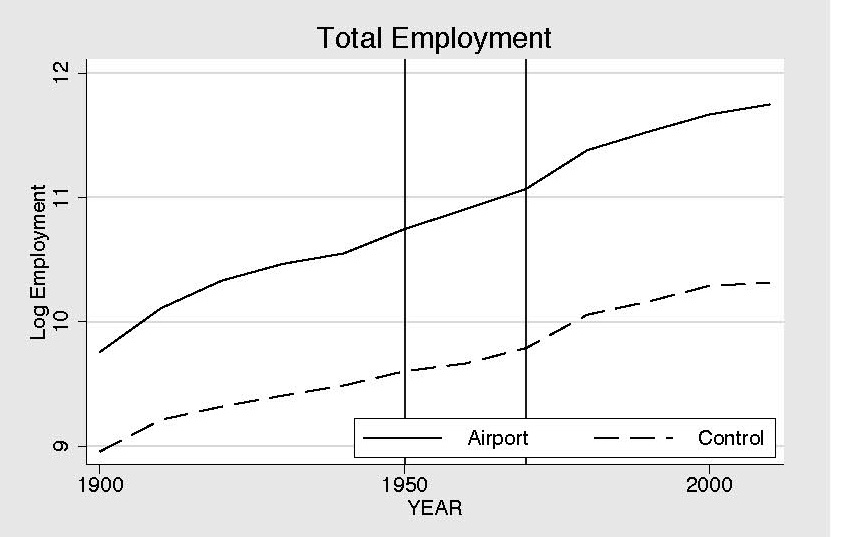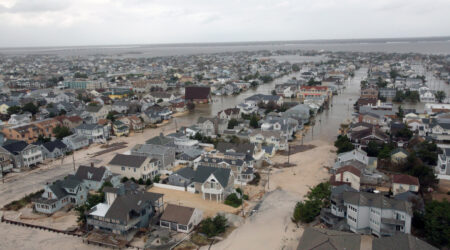“Rebuilding our nation’s infrastructure” has become a political rallying cry in recent years. Barack Obama punctuated his 2014 State of the Union with much-lauded references to public works projects. Congressional Representatives from Rhode Island to Illinois to California have built political platforms around infrastructure programs. A recent report from the American Society of Civil Engineers decried the state of the nation’s roads, rails, and waterway, assigned them a shameful “D+”, and called for immediate investment of $3.6 trillion dollars to remedy the situation. Sponsors of appropriation bills, meanwhile, offer assurances that infrastructure investment will generate hefty returns.
But is it all just hype?
Not according to “Perhaps the Sky’s the Limit? Airports and Employment in Local Economies”, a paper by UC Berkeley Economics PhD Candidate Marquise McGraw, whose research affirms that investing in at least one type of transportation infrastructure—airports—is indeed well worth the cost, particularly at a local scale. McGraw has dedicated years to understanding the relationship between infrastructure and local economic growth. His study, which analyzed the impacts of airports built between 1950-2010, suggests that metropolitan areas across the U.S. have reaped significant rewards from investing early, significantly, and consistently in airports.
As detailed in the report’s abstract: “Relative to non-airport cities, the presence of an airport in a [census-based statistical area] has caused population growth ranging between 14.6 percent and 29 percent, total employment growth of between 17.4 percent and 36.6 percent, tradable industry employment growth of between 26.6 percent and 42.6 percent, and non-tradable industry employment growth of between a non-statistically significant 2.7 percent and 16.1 percent…. On average, an airport generates $83.8 million in added payroll and 3,300 jobs for a local economy, of which roughly 950 are in tradable industries….”
To reach his conclusions, McGraw examined the economies of select American metropolitan areas over the course of sixty years, well before airports were relevant to private business. He identified a group of all cities that constructed airports during the first years of commercial use, excluding cities like San Francisco and New York, which tended to grow regardless of any single innovation. He then compared the economic development of his sample of urban areas to another group of otherwise similar cities that could have received airports, but did not. McGraw designed an algorithm that controlled for disparities between the two groups beyond the presence of airports, such as differences in population, industry, educational institutions, and other transportation networks. His conclusion: differences abounded between the economies of metropolitan areas with airports and those without.
How much growth did airports stimulate? His results suggest that airport-equipped urban areas might have grown as much as a fifth more than those without airports over the period of study. “I can say that there is a rather large effect,” McGraw says.
He also found that cities with airports were less likely to suffer during times of broad economic downturns or industry-wide closures. “A lot of firms made their location decisions very quickly,” he explains. “They saw that there is going to be an airport, and decided, ‘We’re going to move there.’ With manufacturing, it turns out that … airports helped to retain a lot of manufacturing jobs.”
In other words, cities with aviation infrastructure prove far more resilient to economic turbulence than others, especially in terms of employment. McGraw also found that growth in retail, manufacturing, transportation, and wholesale trade sectors were all consistently higher among the metropolitan areas that received airports.

McGraw’s research offers important contributions to social scientists studying the effects of globalizing economies, as it reinforces a growing body of work showing that globalization does not obviate the significance of location. As evidence, he points to the multiplier effect in employment, as detailed in The New Geography of Jobs, written by UC Berkeley economist Enrico Moretti (McGraw’s advisor), who found that the creation of one tech job may generate as many as five other local jobs. Airport jobs appear to generate even more local jobs, significantly boosting local economies. Conversely, few urban areas without airports fared well in terms of economic growth or employment in the 20th-century economy. Even in an interconnected world, McGraw says, “place does matter.”
The first two to three decades of commercial air travel brought enormous gains for economies with airports, but from the 1980s until fairly recently, growth leveled off. Since then, a notable shift has occurred. “Aviation is increasing in its importance to local economies today,” McGraw says. “Transportation is such a huge part of G.D.P. It’s something on the order of 10% of what we do in America.”
Why would location be so important to business in an age of high-speed, digital communication and virtual consumption? Economists like McGraw believe that the process of agglomeration is at work. Simply put, people innovate best when they work in close proximity and can share ideas. These “knowledge spillovers” possess enormous potential to generate new products and sustain long-term growth for local communities. Think Silicon Valley or Hollywood. The airport, McGraw reasons, “is bringing people together.”
Historically, those cities that invested early and heavily in airports benefitted most from their investments. San Diego and Oakland were among those early investors, and they had a “first-mover advantage” in attracting airlines, investors, and firms. To McGraw, those cities are examples of municipalities “taking control of their own destinies…. It really is the responsibility of local leaders to decide what it takes to develop their own growth.”
While McGraw is not arguing that all cities should begin building new airports, he stresses that communities with airports already in place should support them, and local leaders should take the reins in infrastructure development. “We’re in an age where the federal government isn’t going to be able to solve all our problems any more,” he says. “Cities are the new labs of democracy; cities are where the innovation is happening.”



